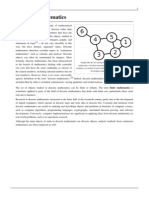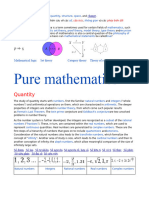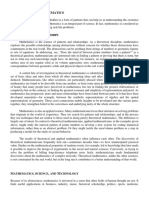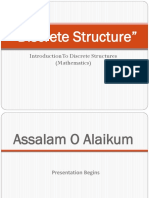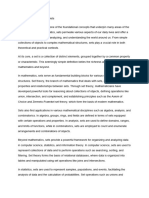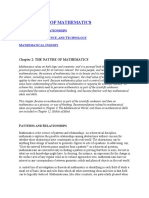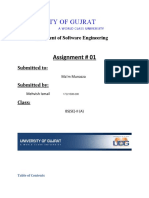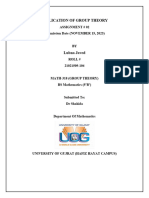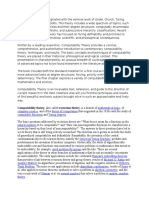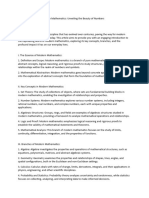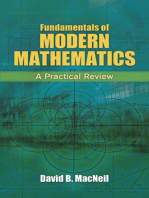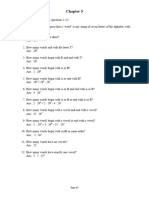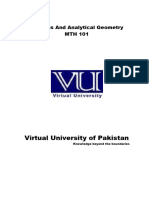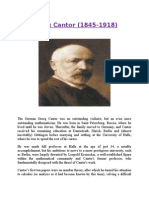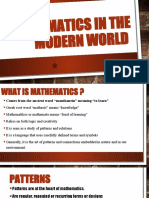Set Theory
Set Theory
Uploaded by
hogr6722Copyright:
Available Formats
Set Theory
Set Theory
Uploaded by
hogr6722Original Title
Copyright
Available Formats
Share this document
Did you find this document useful?
Is this content inappropriate?
Copyright:
Available Formats
Set Theory
Set Theory
Uploaded by
hogr6722Copyright:
Available Formats
Set Theory: Foundations and Applications in Modern Mathematics
Abstract
Set theory, the study of collections of objects known as sets, is the foundational language of
modern mathematics. Developed in the late 19th century by German mathematician Georg
Cantor, set theory underpins nearly every branch of mathematics, providing a framework for
understanding collections, relations, and functions. This paper examines the key concepts of set
theory, its significance in the development of mathematical logic, and its applications in fields
ranging from computer science to topology.
Introduction
Set theory formalizes the concept of a “set,” which is a collection of distinct objects considered
as a single entity. Elements within a set can be numbers, shapes, or even other sets, allowing
for the construction of complex mathematical systems. Since its inception, set theory has
revolutionized mathematics, establishing rigorous definitions and structures for objects and
relationships. This theoretical foundation is essential for understanding infinity, arithmetic, and
logic, making it indispensable for both pure and applied mathematics.
Key Concepts in Set Theory
1. Sets and Elements: In set theory, a set is represented by listing its elements
within curly brackets, such as S = \{1, 2, 3\} . An element x belongs to a set S if x \in S . Sets
can be finite or infinite, and subsets, which are sets contained within other sets, form an
essential part of the theory.
2. Operations on Sets: Key operations include union, intersection, and difference.
The union of two sets A and B , denoted A \cup B , includes all elements in either A or B .
The intersection, A \cap B , includes elements present in both sets, while the difference, A - B ,
includes elements in A that are not in B . These operations help analyze relationships
between different collections and are foundational in probability and logic.
3. Cardinality and Infinite Sets: Cardinality measures the size of a set, such as the
number of elements in a finite set. Cantor introduced the concept of different sizes of infinity
through cardinality, showing that the set of real numbers has a greater cardinality than the set of
natural numbers. This insight into infinite sets challenges intuition and has led to profound
philosophical discussions in mathematics.
Applications of Set Theory
Set theory’s principles are integral to various fields:
1. Mathematical Foundations: Set theory provides the basis for mathematical
structures such as functions, relations, and numbers. In mathematical logic, set theory helps
construct proofs and solve problems involving infinity, serving as the basis for axiomatic
systems. Zermelo-Fraenkel set theory, with the Axiom of Choice, forms the standard foundation
for modern mathematics.
2. Computer Science: In computer science, set theory is essential for database
design, algorithms, and programming languages. Sets are used in defining data structures, such
as lists and arrays, and in organizing data retrieval. Logic and set operations also play a crucial
role in computational complexity, which is the study of algorithm efficiency.
3. Topology: Set theory is fundamental to topology, a branch of mathematics that
studies properties of space preserved through continuous transformations. Open and closed
sets, as well as other topological concepts, rely on set theory, allowing mathematicians to
understand and analyze geometric shapes in abstract spaces.
Conclusion
Set theory is more than just a mathematical tool; it is the language that defines mathematics
itself. By formalizing the concept of collections and relationships, set theory has provided the
structure needed for rigorous proof and logic. Its applications extend beyond pure mathematics,
impacting fields such as computer science, logic, and topology. Through set theory, we gain
insights into the nature of infinity, logic, and the very foundations of mathematical thought,
establishing it as a critical framework for understanding and advancing mathematical
knowledge.
You might also like
- Discrete Mathematics A Concise IntroductionDocument266 pagesDiscrete Mathematics A Concise Introductionmalanga.bangaNo ratings yet
- Applications of Discrete Mathematics in Computer Science: Presentation by - Chetan ParateDocument14 pagesApplications of Discrete Mathematics in Computer Science: Presentation by - Chetan ParatejohnNo ratings yet
- Class 9 Maths Olympiad Logical Reasoning Practice PapersDocument26 pagesClass 9 Maths Olympiad Logical Reasoning Practice Paperslokesh kumarNo ratings yet
- 1 - Dms Introduction To Dms and Set TheoryDocument43 pages1 - Dms Introduction To Dms and Set TheoryAnime FreakNo ratings yet
- The Depth and Beauty of MathematicsDocument4 pagesThe Depth and Beauty of Mathematicspigis58346No ratings yet
- The Essence of Set TheoryDocument29 pagesThe Essence of Set TheoryGuillermo CalderaroNo ratings yet
- Pure Maths Book 1Document2 pagesPure Maths Book 1ktfrdalepayfakwpipNo ratings yet
- Discrete MathematicsDocument8 pagesDiscrete MathematicsAhmad AlhourNo ratings yet
- Areas of MathematicsDocument7 pagesAreas of MathematicsjosebardamuNo ratings yet
- Toan HocDocument6 pagesToan HocLưuVănViếtNo ratings yet
- Math ReviewerDocument2 pagesMath ReviewerJay Lester UrsolinoNo ratings yet
- Introduction To Discrete MathematicsDocument10 pagesIntroduction To Discrete Mathematicsgd2782001No ratings yet
- MathematicsDocument5 pagesMathematicsuni.english.tutor.sbaNo ratings yet
- The Nature of Mathematics: Atterns and ElationshipsDocument4 pagesThe Nature of Mathematics: Atterns and ElationshipsNEPERESM TALCEY BORCESNo ratings yet
- Discrete StructureDocument25 pagesDiscrete StructureShëikh M ĀhmädNo ratings yet
- Numbers, Sets and Axioms - Hamilton PDFDocument265 pagesNumbers, Sets and Axioms - Hamilton PDFmanuel83% (6)
- SETSDocument10 pagesSETSgp5514875No ratings yet
- mathssDocument2 pagesmathssvedmahadik23No ratings yet
- Set ApplicationDocument1 pageSet ApplicationrshegdeNo ratings yet
- Discrete MathematicsDocument8 pagesDiscrete MathematicsIsaac SalinasNo ratings yet
- MATHEMATICSIN THE MODERN WORLD CHAPTER IDocument8 pagesMATHEMATICSIN THE MODERN WORLD CHAPTER Ixamppmysql20No ratings yet
- Discrete MathematicsDocument8 pagesDiscrete Mathematicssweetwaqar0% (1)
- Fuzzy X (Set Theory + Logic) - MAH, 2013Document85 pagesFuzzy X (Set Theory + Logic) - MAH, 2013newmetroNo ratings yet
- Untitled DocumentDocument2 pagesUntitled Documentfalconace94No ratings yet
- Chapter 2 Summary and Learning InsightsDocument1 pageChapter 2 Summary and Learning InsightsRichel Borres MangmangNo ratings yet
- Combinatorics: Combinatorics Is An Area of Mathematics Primarily Concerned With Counting, Both As A Means and An EndDocument9 pagesCombinatorics: Combinatorics Is An Area of Mathematics Primarily Concerned With Counting, Both As A Means and An EndK. M. Junayed AhmedNo ratings yet
- The Nature of Mathematics: P R M S T M IDocument6 pagesThe Nature of Mathematics: P R M S T M IRaymond AzoresNo ratings yet
- Quaternion Thesis CHAPTER 1Document7 pagesQuaternion Thesis CHAPTER 1aldrin_mathNo ratings yet
- Why Study MathematicsDocument2 pagesWhy Study MathematicsAryo WibisonoNo ratings yet
- Chapter 2: The Nature of Mathematics: Atterns and ElationshipsDocument5 pagesChapter 2: The Nature of Mathematics: Atterns and Elationshipsnurhana91No ratings yet
- Science of Computer Programming: Roland Backhouse, João F. FerreiraDocument21 pagesScience of Computer Programming: Roland Backhouse, João F. FerreiraELOK YULIA FAIKOHNo ratings yet
- Assignment 1 - CSE 181.1Document6 pagesAssignment 1 - CSE 181.1Al Sany TamimNo ratings yet
- Mathscietech Lesson 2Document4 pagesMathscietech Lesson 2John RamirezNo ratings yet
- Model Logic MathematicalDocument3 pagesModel Logic Mathematicaljordan lupeNo ratings yet
- The Nature of MathematicsDocument6 pagesThe Nature of MathematicsTeejay AndradaNo ratings yet
- University of Gujrat: Assignment # 01Document6 pagesUniversity of Gujrat: Assignment # 01itsfakeNo ratings yet
- Discrete Mathematics in The Real Life F 1Document13 pagesDiscrete Mathematics in The Real Life F 1api-535586809No ratings yet
- Automata and Complexity Theory ModuleDocument104 pagesAutomata and Complexity Theory ModuleSurafelNo ratings yet
- Lovasz Discrete and ContinuousDocument23 pagesLovasz Discrete and ContinuousVasiliki VelonaNo ratings yet
- Group Theory 1Document6 pagesGroup Theory 1hayatianjourneyNo ratings yet
- HIMA PROJECT Mark Joseph UrianDocument72 pagesHIMA PROJECT Mark Joseph UrianLydia AlbanNo ratings yet
- Modern MathematicsDocument13 pagesModern Mathematicssoumimaity03No ratings yet
- JETIR1901H53Document3 pagesJETIR1901H53asikuhamuzaNo ratings yet
- StructureDocument2 pagesStructurepoojaNo ratings yet
- The Universality and Beauty of MathematicsDocument4 pagesThe Universality and Beauty of Mathematicsijlal.ashrafNo ratings yet
- Fundamentals of Real and Complex Analysis: Asuman Güven AksoyDocument402 pagesFundamentals of Real and Complex Analysis: Asuman Güven AksoyCyanPowderNo ratings yet
- Metric Spaces: Chapter - LDocument2 pagesMetric Spaces: Chapter - Lshahzeb khanNo ratings yet
- ProjectDocument83 pagesProjectSg_manikandanNo ratings yet
- Set TheoryDocument5 pagesSet TheoryJasvinder SinghNo ratings yet
- Computability TheoryDocument2 pagesComputability TheorySanjidaNo ratings yet
- Seven VirtuesDocument37 pagesSeven Virtuesbunnyzeko1No ratings yet
- 1405.5956v1Document15 pages1405.5956v1whaqpiNo ratings yet
- Mathematical AnalysisDocument11 pagesMathematical AnalysisjosgauNo ratings yet
- Certainl 1Document2 pagesCertainl 1s.bagol.542504No ratings yet
- The Objectives of Discrete Mathematical Structures AreDocument30 pagesThe Objectives of Discrete Mathematical Structures AreKarthikeyan RamajayamNo ratings yet
- CMP250 Mathematics For ComputersDocument142 pagesCMP250 Mathematics For ComputersAniket Jadhav100% (1)
- Ebrahim-2016 EvolutionOfNumberMathematics 6ppDocument6 pagesEbrahim-2016 EvolutionOfNumberMathematics 6ppAssad EbrahimNo ratings yet
- MathmaticsDocument2 pagesMathmaticssamarthpatil1402No ratings yet
- The Math You Need: A Comprehensive Survey of Undergraduate MathematicsFrom EverandThe Math You Need: A Comprehensive Survey of Undergraduate MathematicsNo ratings yet
- Chapter 05Document18 pagesChapter 05Jose D. Elvena Jr.No ratings yet
- June 2022-Demo-Dlp-Finding The Probability of Simple EventsDocument7 pagesJune 2022-Demo-Dlp-Finding The Probability of Simple EventsAngela Camille Paynante100% (1)
- DLP 6 Math Q3 Nov. 25 29 Week 5Document18 pagesDLP 6 Math Q3 Nov. 25 29 Week 5Johniel Bustamante100% (1)
- MTH101 Highlighted Handouts (1)Document300 pagesMTH101 Highlighted Handouts (1)saqibmajeedsaqibmajeed52No ratings yet
- Free Sample GED Math Test - Answer Key and GuideDocument7 pagesFree Sample GED Math Test - Answer Key and GuideLenaNo ratings yet
- Georg CantorDocument4 pagesGeorg CantorsreyakNo ratings yet
- Ascending Mathematics Part 1 Ascending Numbers and NomenclatureDocument24 pagesAscending Mathematics Part 1 Ascending Numbers and NomenclatureKentu KemptahNo ratings yet
- Class 2 - C - N 2 - Directed Numbers, Number Types, Fractions, Calculator UseDocument5 pagesClass 2 - C - N 2 - Directed Numbers, Number Types, Fractions, Calculator UseTeshanna MunroNo ratings yet
- Chapter 2 SETSDocument13 pagesChapter 2 SETSNem MoreraNo ratings yet
- Pgdca-123 ConamDocument10 pagesPgdca-123 Conamrajendrarajpurohit19No ratings yet
- Math Prep1 2ndDocument132 pagesMath Prep1 2ndhothanhtrucNo ratings yet
- Case Study Question - 1Document2 pagesCase Study Question - 1naseerhamdan2No ratings yet
- Homework Questions and AnswersDocument4 pagesHomework Questions and Answersg3v3q3ng100% (1)
- Practice Test 1Document6 pagesPractice Test 1NATHANIEL GALOPONo ratings yet
- 1st Quarter Mathematics 7 CMDocument4 pages1st Quarter Mathematics 7 CMJeff LacasandileNo ratings yet
- WS Angles: How Many of The Labelled Angles in The Figure Below Are Greater Than A Right Angle?Document5 pagesWS Angles: How Many of The Labelled Angles in The Figure Below Are Greater Than A Right Angle?ikaNo ratings yet
- Chapter 3 - DecimalsDocument27 pagesChapter 3 - DecimalsEfren Lazaro100% (1)
- Get Solutions Manual To Accompany A Graphical Approach To Algebra and Trigonometry 5th Edition 9780321644725 Free All Chapters AvailableDocument25 pagesGet Solutions Manual To Accompany A Graphical Approach To Algebra and Trigonometry 5th Edition 9780321644725 Free All Chapters Availablefimanumero100% (4)
- Mathematics in The Modern WorldDocument63 pagesMathematics in The Modern WorldNieL ReSpiCiONo ratings yet
- 11 Ip List of Programs for Practical File (1)Document3 pages11 Ip List of Programs for Practical File (1)adityaguptakpsNo ratings yet
- IGCSE Core Math 3rd Edition NotesDocument64 pagesIGCSE Core Math 3rd Edition NotesShepherd HomeschoolNo ratings yet
- KODE: 3499: Reading TestDocument24 pagesKODE: 3499: Reading TestDewi SithaNo ratings yet
- Table of Specification 1Document25 pagesTable of Specification 1Loiweza AbagaNo ratings yet
- (2nd) CSE Reviewer Questionaire With AnswersDocument134 pages(2nd) CSE Reviewer Questionaire With AnswersGirlie Jean ZigaNo ratings yet
- Algebra 1 Ch. 1 Extra PracticeDocument2 pagesAlgebra 1 Ch. 1 Extra Practicewenatchee25No ratings yet
- Co2 Lesson Plan in MathDocument12 pagesCo2 Lesson Plan in MathMae Ervynn BeltranNo ratings yet
- Qualifying Assessment Test and Pre-Requisite Competencies: Directive 1.20Document23 pagesQualifying Assessment Test and Pre-Requisite Competencies: Directive 1.20Rana Muhammad Ayyaz RasulNo ratings yet
- 01 Computer Applications in Pharmacy Full Unit IDocument12 pages01 Computer Applications in Pharmacy Full Unit ISinh LuyenNo ratings yet







